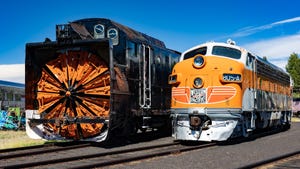
Rails to the Past: Exploring the Western Pacific Railroad Museum - CNET
Northeast of Sacramento, high in the Sierra Nevada mountains, lies Portola. It’s a small town in an area of tiny towns, notable for one thing: It’s the crew change site for the Western Pacific Railroad, now known as the Union Pacific. The huge railyard is incongruous here among the hills, pines and firs.
Adjacent to the railyard, aging locomotives, boxcars, and cabooses sit like forgotten toys of a giant trainspotter. Once powerful and remarkable machines, they now rest quietly in a retirement of cold winters and high altitude. For a few days a week, during just a few months of every year, you can explore these well-worn machines. This is the Western Pacific Railroad Museum, a unique and impressive collection and easily one of the best museums of its type in the country.
My favorite part of the visit? Unlike most museums, I was able to climb in and around just about everything. So, of course, I did exactly that. Here’s how it all looks.
I’m on the California Zephyr, watching America roll by
It’s a clear day when I finally arrive at the Western Pacific Railroad Museum. I had set out that morning from the coast, cutting across the state after marveling at the giant redwoods. The drive, curving through several national forests, is one I highly recommend.
The museum lies at the end of a short, unpaved road on the edge of town. While there are several locomotives and cabooses arrayed on either side of the entrance path, my eyes naturally drift to the enormous EMD DD40X. It’s an absolute monster, proudly dressed in Union Pacific livery, the only operator of the type. These “Centennials” are the most powerful diesel locomotives of their kind, and this one in particular was the last built.

Nearly 100 feet long, and sporting 6,600 horsepower, the EMD DD40X is a behemoth.
Geoff Morrison/CNET
Inside the museum’s only shed is a restoration shop, museum shop and several coaches. One of the latter you can explore, and it’s quite the step back in time. While there are a few “modern” amenities like a 40-year-old stereo system, the rest is largely untouched since its years of service in the middle of the last century. Some of it dates back to when the coach was first built, over 100 years ago.
Exploring outside more, I find several original California Zephyr coaches. The museum is hoping to acquire and restore more of these, since Western Pacific operated the line for most of its service life.

This is the first GP20 built by EMD. It still runs.
Geoff Morrison/CNET
Most railroad museums feature and maintain far older, steam locomotives. The WPRM is restoring one of their own, but predominantly what you find here are the hulking diesels of the mid-20th century. This is my favorite era, before jet travel but after the age of steam.
The farther you explore from the train shed, the more time has had its way with the machines. Faded colors and the slow procession of rust start to dominate. These older, or less important vehicles are still a significant part of the history of the railroad, but with limited funds not everything can be preserved. At least not to the pristine extent of many of the locomotives at the museum.
It’s the California Zephyr, the Union Pacific Queen

An EMD FP7 locomotive that pulled the California Zephyr through the west for 20 years in the last century.
Geoff Morrison/CNET
Most train museums, in the US at least, feature far older locomotives than those of the Western Pacific Railroad Museum. Sure, they might have a few diesels, but that’s rarely the focus. Seeing so many here, especially so many important vehicles from one company’s history, is a treat. Being able to explore so many of them, inside and out, makes the WPRM definitely worth the trip.
However, it’s tricky to find the time for that trip. The museum is closed in the winter, which isn’t surprising given the altitude and climate. During the months the museum is open, it’s typically just open Thursday through Sunday. There are train rides on most weekends though. And while I didn’t get a chance to do it, the museum is well known in trainspotting circles for its Run A Locomotive program, where you get to drive an actual locomotive (under supervision, of course).
If Northern California isn’t on your travel schedule right now, check out the gallery above for a closer look in and around many of these historic and impressive trains.
As well as covering TV and other display tech, Geoff does photo tours of cool museums and locations around the world, including nuclear submarines, massive aircraft carriers, medieval castles, epic 10,000-mile road trips, and more. Check out Tech Treks for all his tours and adventures.
He wrote a bestselling sci-fi novel about city-size submarines and a sequel. You can follow his adventures on Instagram and his YouTube channel.


